AP-REITs: a return to fundamentals
Like all risk assets, AP REITs experienced a volatile 2022. Higher rates globally were driven by surging energy prices and inflation, and there were concerns of cap-rate expansion leading to pressure across the asset class. Moving into 2023, against a potentially more normalized macro landscape, we believe investors should refocus on the fundamentals underpinning the asset class in the region, such as strong balance sheets, positive rental growth, and sustainable dividend payouts.

2022 was a challenging year for all asset classes, but the fundamentals of Asia-Pacific real estate investment trusts (AP REITs) remained resilient despite the risk-off environment. This was evidenced by their earnings and guidance. In addition, asset values remained buoyant, driven by healthy rental growth and growth in distribution following the cessation of rental relief measures.
In the new year, we believe that investors will shift their attention to the underlying fundamentals of AP REITs as the period of interest-rate volatility that dented overall REIT performance in 2022 comes to an end and rates begin to stabilize. In turn, this should pave the path for a more normalized market environment.
From an asset-class perspective, investors should remember that dividend returns are a central feature of the REIT asset class—when markets decline, dividends help compensate for any price losses. Crucially, regardless of the market environment over the past decade, dividend return has remained positive. As such, when markets move higher, dividends augment total return.
AP REITs total return: 2010-2022 (year to date)
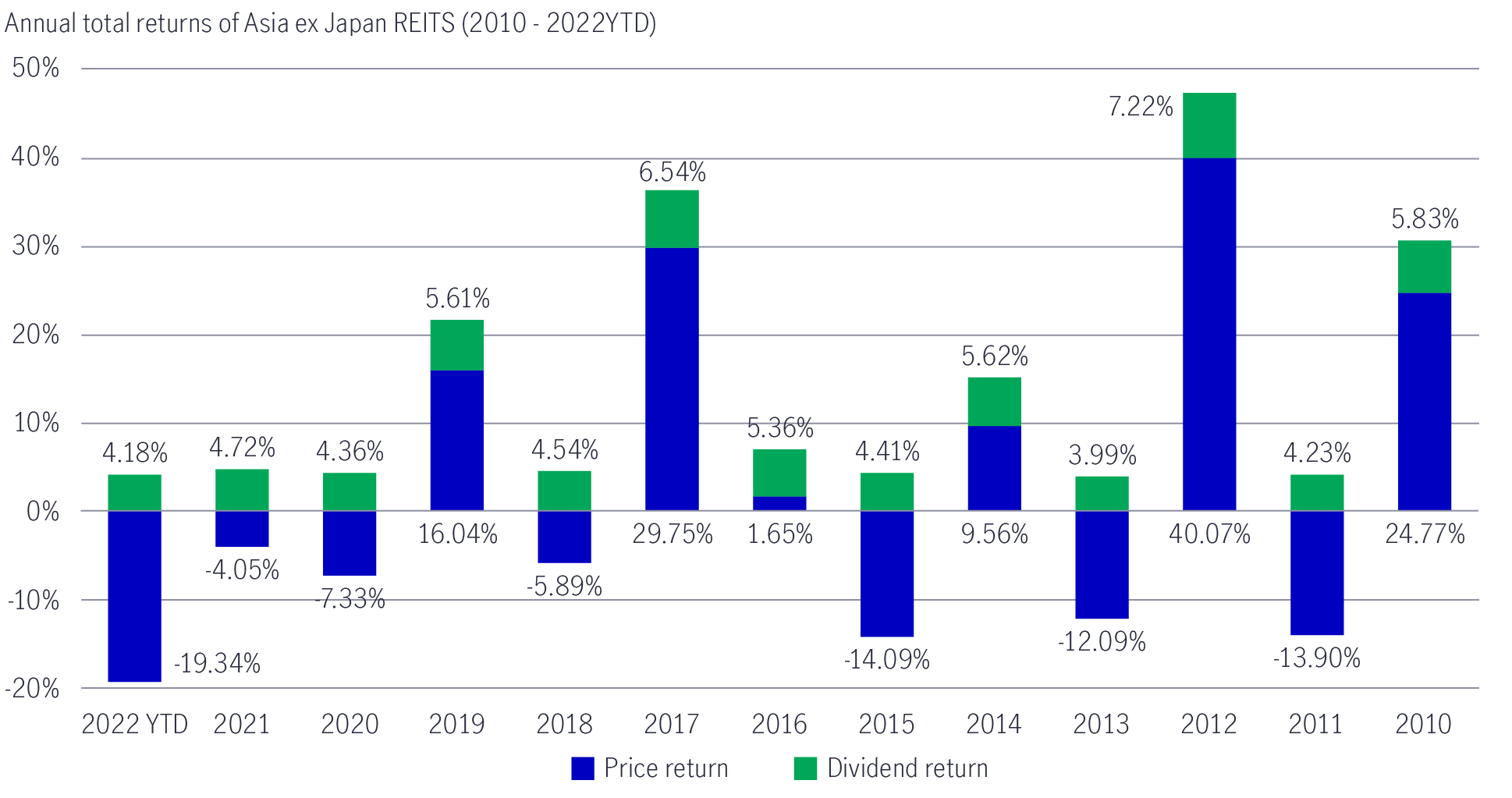
2022: higher rates amid inflationary pressures
Worries about the impact of higher rates and energy costs on asset values and the asset class’s profitability more or less defined a challenging 2022. This translated into market uncertainty about the ability of these asset managers to maintain their distributions to investors.
As interest rates rose over the year, investor concerns persisted on potentially lower asset values due to rising cap rates; however, we felt the level of drawdown priced into AP REITs due to higher rates wasn’t indicative of their underlying operational performance.
AP REITs total return by market, December 2021-November 2022
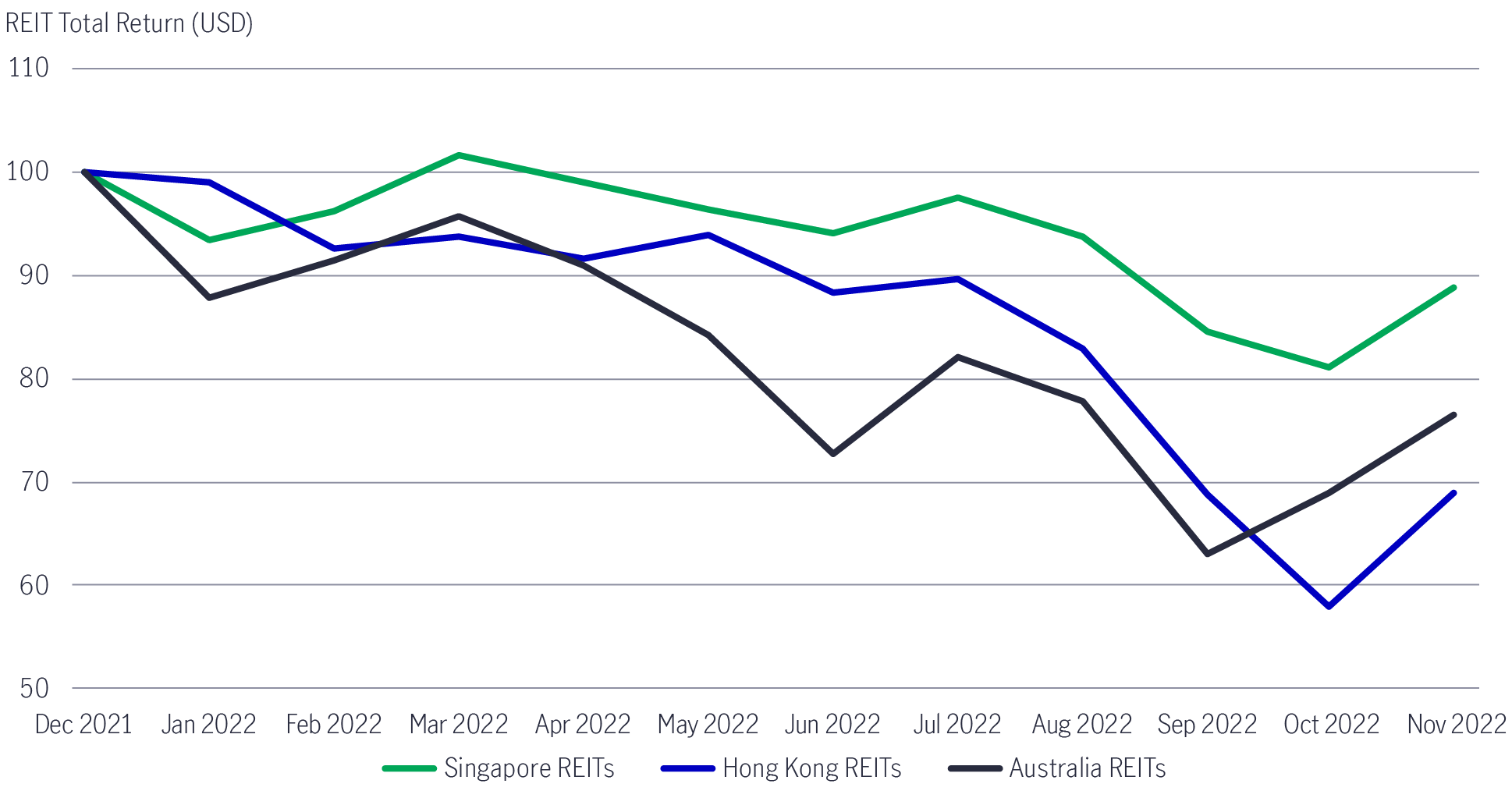
In addition, reopening tailwinds in Asia provided some ballast for the asset class, but these are expected to fade (except for Hong Kong SAR and Mainland China) heading into 2023.
From a geographic perspective:
- Australian REITs tend to be more sensitive to movements in 10-year bond yields than other major REIT markets. The first half of 2022 made this dynamic clear: Yields on the Australian 10-year government bond started at 1.67% and reached a peak of 4.20% by mid-June. The rapid and largely unanticipated increase in rates, which reflected the Reserve Bank of Australia’s aggressive monetary stance, weighed on the REITs sector—the region’s weakest performer through the first half of 2022.
- Hong Kong REITs were affected by negative investor sentiment toward Mainland China for most of the year. Despite the continued loosening of COVID-19 measures at the local level, financial distress in the country’s property sector and the closure of the China-Hong Kong border spilled over into related sectors, including REITs.
- Singapore REITs were the relative outperformer in Asia-Pacific despite broader concerns about the asset class. Singapore REITs benefited from the reopening of the economy, leading to expectations of a recovery in the retail and hospitality sectors on the back of a rise in convention and exhibition activity. Notwithstanding renewed optimism stemming from the post-COVID-19 economic recovery, macro concerns outweighed operationally positive data points.
Central bank policy still a factor in 2023—but largely priced in
Moving into 2023, the U.S. Federal Reserve is likely to gradually reduce the quantum of rate hikes and should pause as inflationary pressures decelerate; however, the risk of persistent sticky inflation and lower growth in the United States (and elsewhere) still exists, particularly in the second half of the year. Any potential easing in global inflation and labor markets (i.e., wage pressure) could offer central banks more room to balance their goal of supporting growth versus tamping down inflation.
Although the impact of higher rates and energy costs should still be felt in 2023, the impact has been well communicated by corporates.
Indeed, as interest-rate volatility starts to normalize, it may provide a better environment for risk assets, including REITs. As such, we believe the incremental impact of higher rates on interest costs should subside and investors can focus more on AP REITs’ operational performance and underlying fundamentals.
Operating fundamentals should drive performance in 2023
We currently don’t see balance sheet or liquidity risk as key risks for AP REITs given healthy levels of leverage and, more importantly, their ability to service debt. Data shows that current interest coverage ratios (ICR) for key Singapore REITs are well above the typical minimum threshold (i.e., adjusted earnings before interest, tax, depreciation, and amortization are at least two times the required interest payments).
Interest coverage ratio for key Singapore REITs
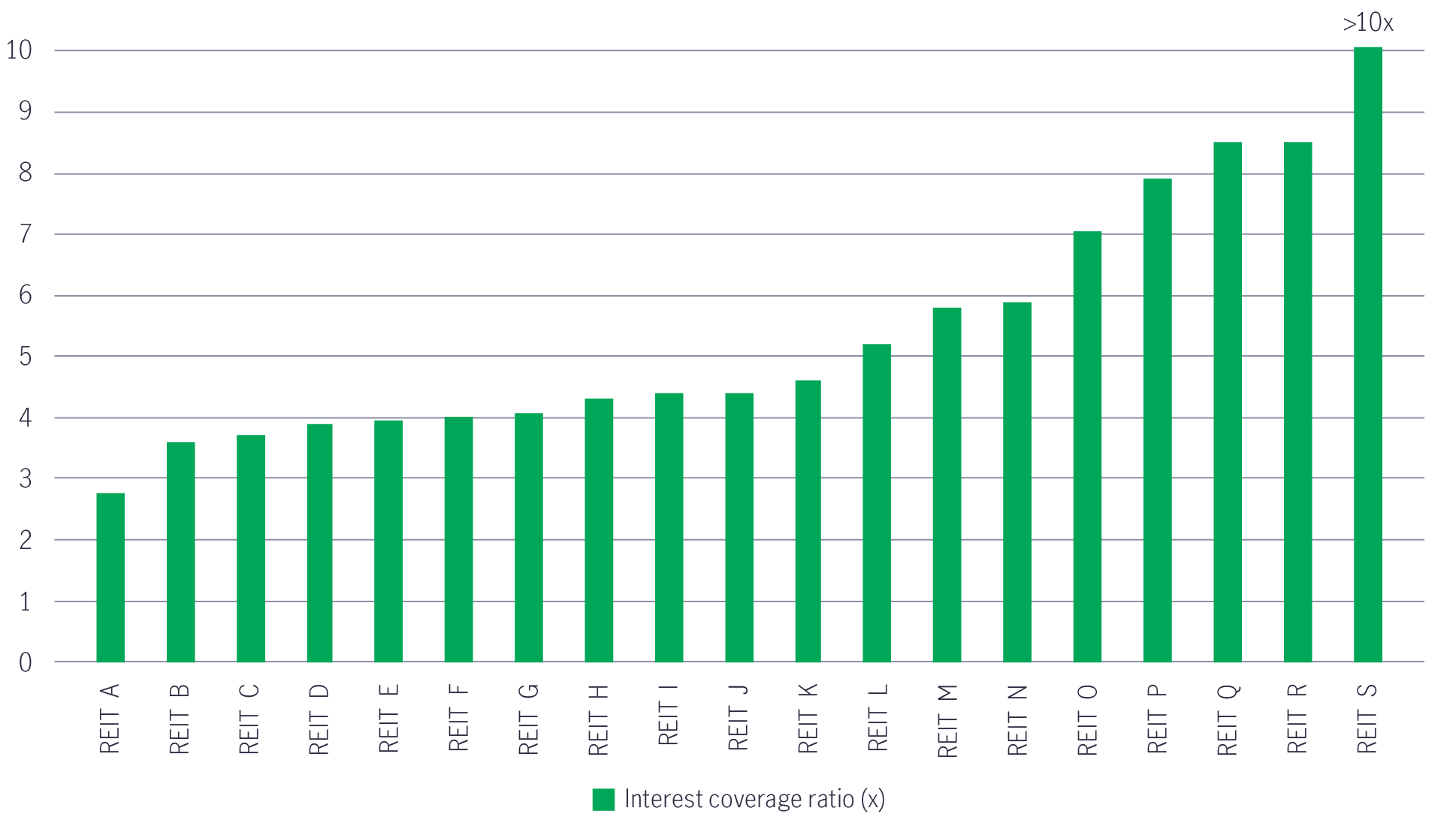
Even if we were to factor in the possibility of higher interest rates, refinancing risks are staggered over a few years. In addition, rising net property income could also help to mitigate the overall impact of higher rates on ICR.1
Further, rental reversions are likely to be positive in the industrial, hospitality, and retail sectors in 2023. Given high occupancy and the continued demand in e-commerce and logistics warehousing, we could see continued positive rental reversions, which should help to partially mitigate the effect of cap-rate expansion on asset values.
Finally, we also expect dividend growth to continue. Despite recent downward revisions in analyst expectations on the back of some of the aforementioned challenges, there remains expectations for distribution-per-unit growth (the amount of dividends an investor receives for every unit of REIT held) to be maintained through 2024.
Dividend growth tapped to increase
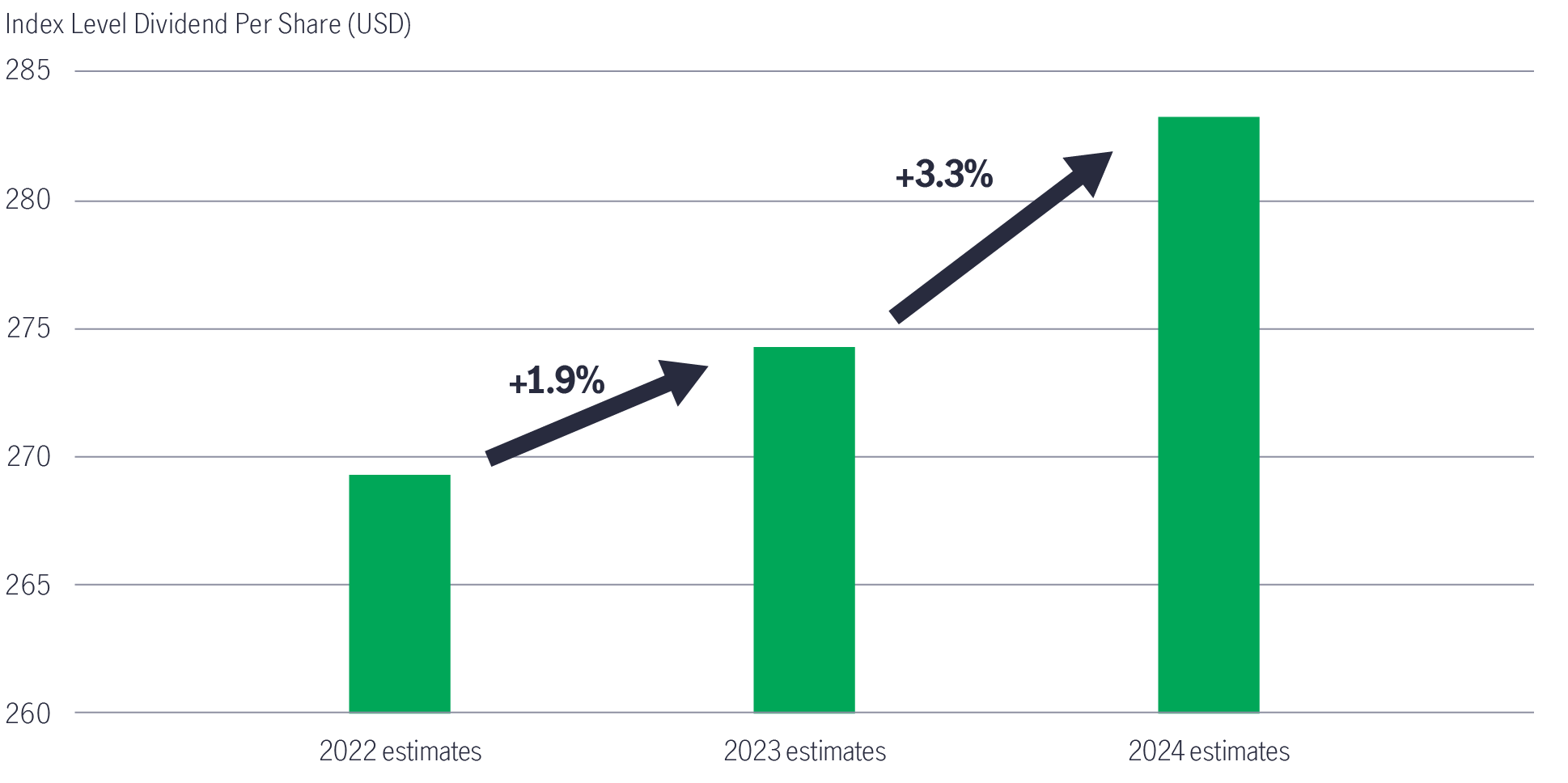
2023 sector outlook: Positive on industrials and retail over offices
We’re more constructive on industrials and retail than offices in 2023.
- In Hong Kong in the retail space, neighborhood malls have generally outperformed during times of economic uncertainty given their nondiscretionary nature. The upward adjustment for minimum wage in 2023 should also provide support. In Singapore, the continued recovery in tourist arrivals should continue to drive an increase in traffic and revenue for malls. The strong rebound in tenant sales has brought down occupancy cost to healthy levels, which allows for more room for potential upside to rental rates.
- Industrials should continue to perform. High occupancy and amplified demand for e-commerce and third-party logistics warehousing should continue into the new year. Longer weighted average lease expiries should provide some cushion to cash flows with more visible rental income.
- We believe that offices should face a challenging year across the region. In Australia, the segment is suffering from a slower-than-expected return to the workplace. Hong Kong should experience a muted recovery with significant supply coming online in 2022–2023. Singapore could see a slowdown in leasing demand and slower pace of rental growth.
2023 AP REIT segment outlook
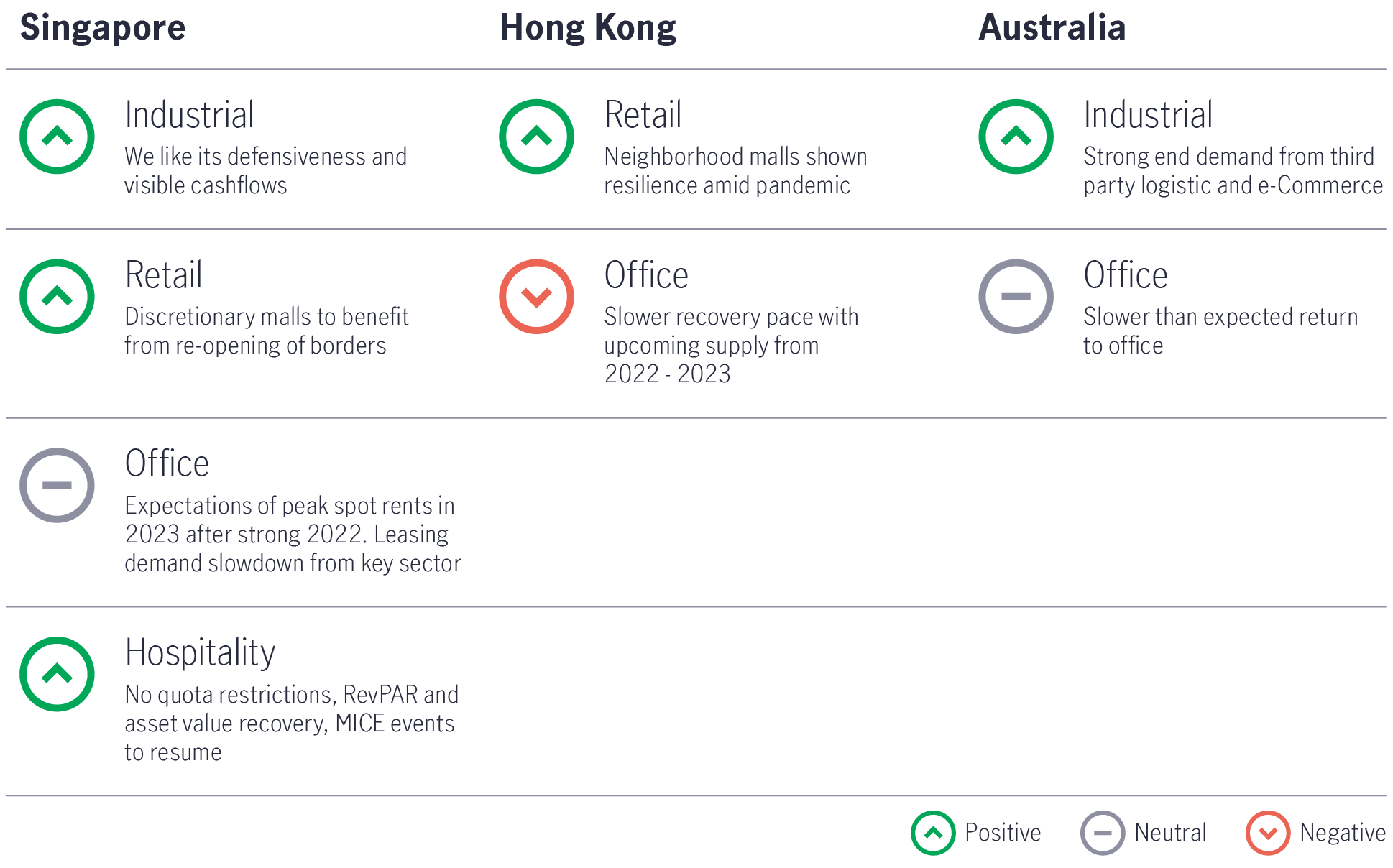
Conclusion
After a difficult 2022, investors in AP REITs should likely look at the asset class’s robust underlying fundamentals in the new year, which we consider as core earnings and cashflow strength, strong capital management, and quality real estate which generally provides greater resilience to rental rates during times of economic uncertainty—all factors which provide support to sustainable dividend payouts.
1 Manulife Investment Management analysis and company reports.
Important disclosures
Investing involves risks, including the potential loss of principal. Financial markets are volatile and can fluctuate significantly in response to company, industry, political, regulatory, market, or economic developments. These risks are magnified for investments made in emerging markets. Currency risk is the risk that fluctuations in exchange rates may adversely affect the value of a portfolio’s investments.
The information provided does not take into account the suitability, investment objectives, financial situation, or particular needs of any specific person. You should consider the suitability of any type of investment for your circumstances and, if necessary, seek professional advice.
This material, intended for the exclusive use by the recipients who are allowable to receive this document under the applicable laws and regulations of the relevant jurisdictions, was produced by, and the opinions expressed are those of, Manulife Investment Management as of the date of this publication, and are subject to change based on market and other conditions. The information and/or analysis contained in this material have been compiled or arrived at from sources believed to be reliable, but Manulife Investment Management does not make any representation as to their accuracy, correctness, usefulness, or completeness and does not accept liability for any loss arising from the use of the information and/or analysis contained. The information in this material may contain projections or other forward-looking statements regarding future events, targets, management discipline, or other expectations, and is only as current as of the date indicated. The information in this document, including statements concerning financial market trends, are based on current market conditions, which will fluctuate and may be superseded by subsequent market events or for other reasons. Manulife Investment Management disclaims any responsibility to update such information.
Neither Manulife Investment Management or its affiliates, nor any of their directors, officers or employees shall assume any liability or responsibility for any direct or indirect loss or damage or any other consequence of any person acting or not acting in reliance on the information contained herein. All overviews and commentary are intended to be general in nature and for current interest. While helpful, these overviews are no substitute for professional tax, investment or legal advice. Clients should seek professional advice for their particular situation. Neither Manulife, Manulife Investment Management, nor any of their affiliates or representatives is providing tax, investment or legal advice. Past performance does not guarantee future results. This material was prepared solely for informational purposes, does not constitute a recommendation, professional advice, an offer or an invitation by or on behalf of Manulife Investment Management to any person to buy or sell any security or adopt any investment strategy, and is no indication of trading intent in any fund or account managed by Manulife Investment Management. No investment strategy or risk management technique can guarantee returns or eliminate risk in any market environment. Diversification or asset allocation does not guarantee a profit nor protect against loss in any market. Unless otherwise specified, all data is sourced from Manulife Investment Management.
Manulife Investment Management
Manulife Investment Management is the global wealth and asset management segment of Manulife Financial Corporation. We draw on more than 150 years of financial stewardship to partner with clients across our institutional, retail, and retirement businesses globally. Our specialist approach to money management includes the highly differentiated strategies of our fixed-income, specialized equity, multi-asset solutions, and private markets teams—along with access to specialized, unaffiliated asset managers from around the world through our multimanager model.
These materials have not been reviewed by, are not registered with any securities or other regulatory authority, and may, where appropriate, be distributed by the following Manulife entities in their respective jurisdictions. Additional information about Manulife Investment Management may be found at manulifeim.com/institutional.
Australia: Hancock Natural Resource Group Australasia Pty Limited., Manulife Investment Management (Hong Kong) Limited. Brazil: Hancock Asset Management Brasil Ltda. Canada: Manulife Investment Management Limited, Manulife Investment Management Distributors Inc., Manulife Investment Management (North America) Limited, Manulife Investment Management Private Markets (Canada) Corp. China: Manulife Overseas Investment Fund Management (Shanghai) Limited Company. European Economic Area and United Kingdom: Manulife Investment Management (Europe) Ltd. which is authorised and regulated by the Financial Conduct Authority, Manulife Investment Management (Ireland) Ltd. which is authorised and regulated by the Central Bank of Ireland Hong Kong: Manulife Investment Management (Hong Kong) Limited. Indonesia: PT Manulife Aset Manajemen Indonesia. Japan: Manulife Asset Investment Management (Japan) Limited. Malaysia: Manulife Investment Management (M) Berhad (formerly known as Manulife Asset Management Services Berhad) 200801033087 (834424-U) Philippines: Manulife Asset Management and Trust Corporation. Singapore: Manulife Investment Management (Singapore) Pte. Ltd. (Company Registration No. 200709952G) South Korea: Manulife Investment Management (Hong Kong) Limited. Switzerland: Manulife IM (Switzerland) LLC. Taiwan: Manulife Investment Management (Taiwan) Co. Ltd. Thailand: Manulife Asset Management (Thailand) Company Limited. United States: John Hancock Investment Management LLC, Manulife Investment Management (US) LLC, Manulife Investment Management Private Markets (US) LLC and Hancock Natural Resource Group, Inc. Vietnam: Manulife Investment Fund Management (Vietnam) Company Limited.
Manulife Investment Management, the Stylized M Design, and Manulife Investment Management & Stylized M Design are trademarks of The Manufacturers Life Insurance Company and are used by it, and by its affiliates under license.
2645346

